| Bust of Bernardino Rivadavia | |
|---|---|
 The bust in 2018 | |
| Subject | Bernardino Rivadavia |
| Location | Cholula, Puebla, Mexico |
The bust of Bernardino Rivadavia is installed in Cholula, Puebla, Mexico. [1]
| Bust of Bernardino Rivadavia | |
|---|---|
 The bust in 2018 | |
| Subject | Bernardino Rivadavia |
| Location | Cholula, Puebla, Mexico |
The bust of Bernardino Rivadavia is installed in Cholula, Puebla, Mexico. [1]

Cholula, officially Cholula de Rivadavia, is a city and district located in the metropolitan area of Puebla, Mexico. Cholula is best known for its Great Pyramid, with the Iglesia de Nuestra Señora de los Remedios sanctuary on top, as well as its numerous churches.

Bernardino de la Trinidad González Rivadavia was the first President of Argentina, then called the United Provinces of the Río de la Plata, from February 8, 1826 to June 27, 1827.

The Casa Rosada is the office of the President of Argentina. The palatial mansion is known officially as Casa de Gobierno. Normally, the President lives at the Quinta de Olivos, the official residence of the President of Argentina, which is located in Olivos, Greater Buenos Aires. The characteristic color of the Casa Rosada is baby pink, and is considered one of the most emblematic buildings in Buenos Aires. The building also houses a museum, which contains objects relating to former presidents of Argentina. It has been declared a National Historic Monument of Argentina.

A chalupa is a specialty dish of south-central Mexico, including the states of Hidalgo, Puebla, Guerrero, and Oaxaca.

Cholula Hot Sauce is a brand of chili-based hot sauce, based in Stamford, Connecticut, manufactured in Chapala, Jalisco, Mexico, and licensed by José Cuervo. According to its manufacturers, Cholula hot sauce rates 1,000-2,000 on the Scoville scale though other sources measure it as being over three times as hot, at 3,600 Scoville units. The product is packaged in a glass bottle with a distinctive round wooden cap. Six varieties of Cholula are widely marketed in North America.

Caballito is a barrio (neighborhood) of the Argentine capital, Buenos Aires. It is the only barrio in the administrative division Comuna 6.

The Spanish conquest of the Aztec Empire, also known as the Conquest of Mexico or the Spanish-Aztec War (1519–21), was one of the primary events in the Spanish colonization of the Americas. There are multiple 16th-century narratives of the events by Spanish conquistadors, their indigenous allies, and the defeated Aztecs. It was not solely a contest between a small contingent of Spaniards defeating the Aztec Empire but rather the creation of a coalition of Spanish invaders with tributaries to the Aztecs, and most especially the Aztecs' indigenous enemies and rivals. They combined forces to defeat the Mexica of Tenochtitlan over a two-year period. For the Spanish, the expedition to Mexico was part of a project of Spanish colonization of the New World after twenty-five years of permanent Spanish settlement and further exploration in the Caribbean.

Cholula was an important city of pre-Columbian Mesoamerica, dating back to at least the 2nd century BCE, with settlement as a village going back at least some thousand years earlier. The site of Cholula is just west of the modern city of Puebla and served as a trading outpost. Its immense pyramid is the largest such structure in the Americas, and the largest pyramid structure by volume in the world.
San Andrés Cholula is the municipal seat of San Andrés Cholula Municipality located in the Metropolitan area of Puebla, in the center west of the state of Puebla in the central highlands of Mexico, 122 km east of Mexico City and eight kilometres west of the city of Puebla. It is one of the two municipalities, along with San Pedro Cholula, that make up the modern city of Cholula or Cholula de Rivadavia. The city of Cholula has been divided into two parts since the pre Hispanic period, when the Toltecs-Chichimecas revolted, took over and pushed the formerly dominant Olmec –Xicallancas to the eastern side of the city. This side of the city is defined as the Great Pyramid of Cholula and east. The city has remained more or less divided since under different political organizations. However, the two halves share a common religious and social tradition which binds the city as a whole. San Andrés is known for being historically indigenous and still contains a larger indigenous population. It is also home to a number of colonial era churches decorated in Talavera tile and in a style called Indigenous or Folk Baroque. The best known example of this is the church in the Santa María Tonatzintla community.
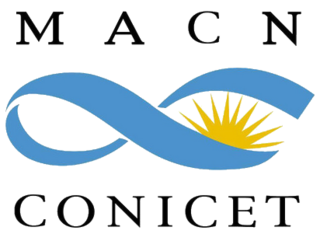
The Bernardino Rivadavia Natural Sciences Argentine Museum is a public museum located in the Caballito section of Buenos Aires, Argentina.
Cholula may refer to:
San Andrés Cholula Municipality is a municipality in Puebla in south-eastern Mexico. It forms part of the Metropolitan area of Puebla, and as of 2011, it is the fastest-growing municipality that conforms the Metropolitan Area, partly because the presence of universities and the wealthiest neighborhoods are located on San Andres Cholula. Along with San Pedro Cholula and Santa Isabel Cholula, it conforms the most ancient still inhabited city in the Americas, Cholula de Rivadabia.
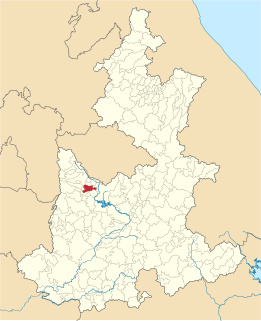
San Pedro Cholula is a municipality in the Mexican state of Puebla and one of two municipalities which made up the city of Cholula. The city has been divided into two sections since the pre Hispanic era, when revolting Toltec-Chichimecas pushed the formerly dominant Olmec-Xicallanca to the eastern side of the city in the 13th century. The new lords called themselves Cholutecas and built a new temple to Quetzalcoatl on the San Pedro side, which eventually eclipsed the formerly prominent Great Pyramid of Cholula, now on the San Andrés side. When the Spanish arrived in the 16th century, the city of Cholula was an important religious and economic center, but the center of power was on the San Pedro side, centered on what is now the main city plaza and the San Gabriel monastery. The division of the city persisted and San Pedro remained the more dominant, with Spanish families moving onto that side and the rest of the population quickly becoming mestizo. Today, San Pedro is still more commercial and less residential than neighboring San Andrés with most of its population employed in industry, commerce and services rather than agriculture. Although Cholula's main tourist attraction, the Pyramid, is in San Andrés, San Pedro has more tourism infrastructure such as hotels, restaurants and bars.
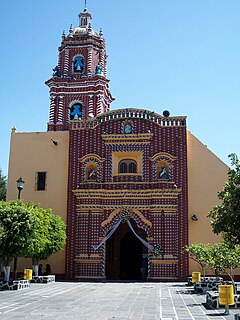
Santa María Tonantzintla is a church in Cholula, Puebla, Mexico.
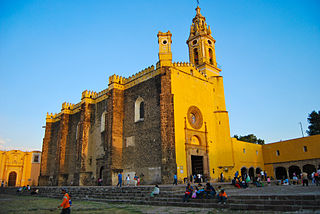
The San Gabriel Franciscan Convent or San Gabriel Friary is a church and friary in Cholula, Metropolitan area of Puebla City, Mexico.
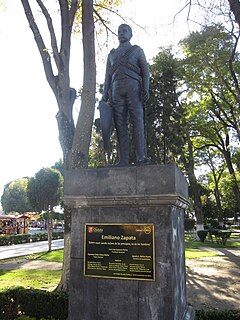
The statue of Emiliano Zapata in Cholula, Puebla, Mexico, was erected by Gobierno Municipal de San Pedro Cholula in 2014.

The statue of Alfredo Toxqui Fernández de Lara in Cholula, Puebla, was erected by Gobierno Municipal de Cholula de Rivadavia in 2004.
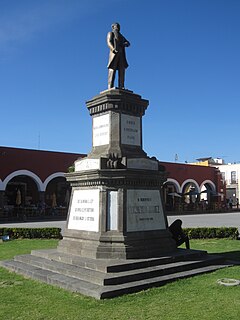
The statue of Benito Juárez is installed in Cholula, Puebla's Plaza de la Concordia, in Mexico.

The statue of Miguel Hidalgo y Costilla is installed in Cholula, Puebla's Plaza de la Concordia, in Mexico.

San Miguel Arcángel Fountain is installed in Cholula, Puebla's Plaza de la Concordia, in Mexico. The fountain was gifted by Philip II of Spain in 1554.